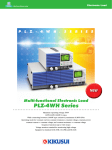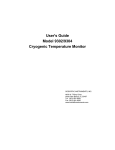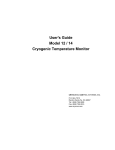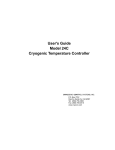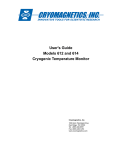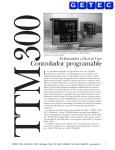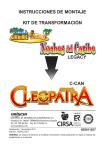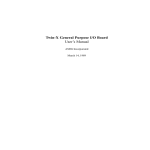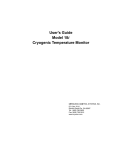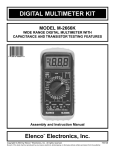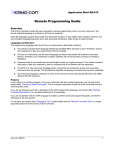Download Model 42/44 Cryogenic Temperature Controllers
Transcript
Cryogenic Temperature Controller Model 42/44 The Model 42/44 cryogenic temperature controllers are the first instruments in their class to extend operation to ultra-low temperature providing robust support for He3 refrigerators at a very cost-effective price. The Model 42 has two multi-purpose inputs and the Model 44 has four. Each input is capable of temperature measurement to below 100mK by using a sophisticated 100μV ratiometric resistance bridge. For general-purpose thermometry applications, the inputs support a wide variety of standard sensors. The dual-output control loop circuits features power levels as high as 50W and as low as 50mW full-scale in order to support ultra-low temperature operation. Cryo-con’s Model 42/44 are the first temperature controllers to incorporate Ethernet connectivity which adds a new dimension of flexibility to industrial and laboratory applications. Major highlights of the Model 42/44: ● Maximum flexibility: Two or four multipurpose input channels support Diode, Platinum RTD and virtually all cryogenic NTC resistive temperature sensors. ● Operation from <100mK to over 1020K with appropriate sensor. ● Constant-Voltage, AC excitation extends the useful temperature range of resistive sensors ● Unique synchronous filter improves control accuracy and stability in cryocooler based systems. ● Dual loop control. Loop #1: 50-Watt, four-range. Loop #2: 10-Watt, two-range. ● Fail-safe cryostat protection features protect user equipment from damage. ● Ethernet interface implements a remote command language in addition to an embedded web server and e-mail. ● Remote interfaces include Ethernet, RS-232 and IEEE-488.2 (GPIB). LabView drivers available. Input Flexibility: The Model 42 has two sensor inputs whereas the Model 44 has four. Each input can be easily configured to support virtually any type of cryogenic thermometer. Configuration is performed from the instrument’s front panel or a remote interface. Silicon Diode sensors from Cryo-con or any other manufacturer are directly supported over their full 1.4 to 500K range using built-in calibration curves and sensor data. Plus, non-volatile Flash memory is available for several custom or calibrated sensors. A unique feature of the Model 42/44 is the use of a ratiometric AC resistance bridge technique to measure Positive Temperature Coefficient (PTC) resistor sensors including Platinum and Rhodium-Iron RTDs. This significantly reduces low frequency noise and drift to provide rock-solid measurements. Sensor excitation used with all resistor sensors is a 3.25Hz bipolar square wave. This effectively cancels thermal EMF induced offset errors that sometimes occur in cryogenic NTC Sensor Resistance Ranges systems. Voltage Min. Max. Bias The excitation 100mV source in the 10.0mV Model 42/44 is 1.0mV continuously 100µV variable so there are no significant steps in sensor self-heating. An additional advantage to constant-voltage excitation is that NTC resistors lose sensitivity in the upper part of their range. By auto-ranging excitation current to maintain a constant voltage, sensitivity and noise immunity in that range is greatly improved. Resistance 40Ω 1.0MΩ 4.0Ω 1.0MΩ 1.0Ω 333KΩ 1.0Ω 33KΩ Model 42/44 Supported Sensors Temperature Range Example Sensors 1.4 - 500K Cryo-con S900, S800. SI-440, 430, 410. Lakeshore DT-670, 470 Platinum RTD 14 - 1200K Cryo-con CP-100 Cryo-con GP-100 Cryo-con XP-100 Cryo-con XP-1K Rhodium-Iron 1.4 - 800K Oxford PHZ 0002 Germanium <100mK 100K Lakeshore GR-200A Carbon Glass 1.4 - 325K Lakeshore CGR-1-500 Diode Platinum RTD sensors use a built-in DIN 43760 (IEC 750) standard curves for 100Ω, 1,000Ω or 10KΩ devices. This curve is used for temperatures from 70K to 1020K and is extended down to 30K for cryogenic use. Operation to about 14K is possible with usersupplied curves. The Model 42/44 provides robust support for the Negative Temperature Coefficient (NTC) sensors commonly used by cryogenic applications. They include Ruthenium-oxide, Carbon-Glass, Cernox, Carbon Ceramic, Germanium and several others. Since these sensors have a negative temperature coefficient, the use of a constant-voltage measurement method will reduce, rather than increase, power dissipation in the sensor as temperature decreases. By maintaining the lowest possible power level, sensor self-heating is minimized and useful temperature range is greatly increased. Resistance Cernox 100mK - 325K Lakeshore, all types Carbon-Ceramic 100mK - 300K TMi-A1 Ruthenium Oxide 50mK - 200K Cryo-con R400 Cryo-con R500 Measurement accuracy is obtained by using 24-bit analog to digital conversion at a minimum sample rate of 15Hz per channel and is further enhanced by extensive use of Digital Signal Processing (DSP). Conversion of a sensor measurement into temperature is performed by using a Cubic Spline interpolation algorithm. In addition to providing higher accuracy than conventional linear interpolation, the Spline function eliminates discontinuities during temperature ramps or sweeps by ensuring that the first and second derivatives are continuous. Input Specifications Diode sensors PTC resistor sensors NTC resistor sensors Excitation Mode DC, Constant-Current Passive AC Resistance Bridge Constant-Voltage AC Resistance Bridge Ranges 2.25V 390Ω, 3.9KΩ, 39KΩ 1.0KΩ, 10KΩ, 100KΩ, 1.0MegΩ Auto or range-hold Accuracy: % of Rdg + % of Range 0.005% + 0.0003% 0.01% + 0.0005% 4 to 30K: 0.05% + 0.05% 0.04 to 1M: 0.15% + 0.15% Resolution: % of Range 0.00004% 0.0003% 0.0003% Excitation Current 1.0mA, 100µA, 10µA Max. 2.5mA to 2.0nA, continuous auto-ranged 10µA DC Sensor Curves: The Model 42/44 includes built-in curves that support most industry standard temperature sensors. Additionally, six user calibration curves are available for custom or calibrated sensors. Each user curve may have up to 200 entries and may be entered from the front panel, or transferred via any of the available remote interfaces. New calibration curves may be generated using the CalGen feature to fit any existing Diode, Platinum or NTC resistor calibration curve at up to three user specified temperature points. This provides an easy and effective method for obtaining higher accuracy temperature measurements without expensive sensor calibrations. The Model 42/44 continuously tracks temperature history, independently on each input channel and provides a statistical summary that indicates the channel's minimum, maximum, average and standard deviation. Also shown are the slope and the offset of the best-fit straight line of temperature history data. Dual Control Loops: The Loop #1 heater output is a linear, low noise RFI filtered current source that can provide up to 1.0 Ampere into 50Ω or 25Ω resistive loads. Four full-scale ranges are available in decade increments down to 50mW. The Model 42/44 will perform a temperature ramp function using a specified maximum ramp rate and target setpoint. Once placed in a ramping control mode, a ramp is initiated by changing the setpoint. The unit will then progress to the new setpoint at the selected ramp rate. Upon reaching the new setpoint, ramp mode will be terminated and standard PID type regulation will be performed. Cryostat Protection: Damage to a cryostat or critical sample is a serious problem with any cryogenic system. The Model 42/44 implements the most robust set of protection features in the industry. The Over Temperature Disconnect feature will disable the heater if an over temperature condition exists on any selected input channel. A fail-safe mechanical relay is used to disconnect the controller's heater thereby ensuring that the user’s equipment is always protected. The Maximum Setpoint feature is used to prevent the user from inadvertently entering a higher setpoint than the equipment can tolerate. Setting the Maximum Power Limit will ensure that the controller can never output a heater power above the set limit. Alarms: The Model 42/44 supports visual, remote The Loop #2 heater output has two output ranges of 10-Watts and 1.0-Watt full-scale into a 50Ω load. and audible alarms. Each may be independently programmed to assert or clear based on a high or low temperature condition or a detected sensor fault. Loop #1 and Loop #2 heaters are completely independent and either heater can be controlled by any sensor input. Latched alarms are asserted on an alarm condition and will remain asserted until cleared by the user. Control modes are Manual, PID, Ramp and PID Table. The industry standard Proportional-IntegralDerivative or PID control loop is implemented as a DSP algorithm and is enhanced to minimize set-point overshoot and differentiator noise. use in extremely low noise environments that cryogenic systems often require. Linear-mode power supplies are used throughout and sensor excitation current sources are not multiplexed. Lowest Noise: The Model 42/44 was designed for Modern components and proven noise management techniques were carefully applied to every sensor excitation and heater output circuit in order to minimize conducted noise. The direction of the control loop can be easily reversed to accommodate thermoelectric type coolers where power is applied to cool rather than heat. The field proven Autotune function of the Model 42/44 involves the use of a specific output waveform to first develop a process model, then generate the optimum P, I and D coefficients. Cryogenic systems often require stable control over a wide range of temperatures. Here, control loop tuning parameters can be significantly different at different temperatures. For this reason, the Model 42/44 offers PID tables that store optimum tuning parameters and heater range vs. setpoint temperature. Six PID tables are available. Each contains PID and heater range settings for up to 16 temperature setpoints. Electrical isolation is used to prevent noise pickup by sensitive analog circuits and to eliminate ground loops. The enclosure of the Model 42/44 is all Aluminum with wide conductive overlaps on all mating metal surfaces so that radiated RFI noise is virtually eliminated. An effective shielding and grounding scheme further allows the user to minimize both conducted and radiated noise. Easy to Use: The Model 42/44’s user interface Utility Software: Utility software is provided that consists of a large, bright Vacuum Fluorescent display and a full, 20-key keypad. All features and functions of the instrument can be accessed via this simple and intuitive menu driven interface. connects any Windows based personal computer to the Model 42/44 via either of its remote interfaces. This software provides a graphical control panel that greatly simplifies instrument setup and configuration. Features include: Accessing primary instrument functions, such as display units and heater setpoint, require only a single key press. More complex features can be accessed by scrolling through short menus. Temperature displays are autoranged to show the most number of significant digits. Built-in filters can be used to smooth temperature data and display resolution can be selected for optimum viewing. Units of K, oC, oF, Volts or Ohms may be selected. Power switch is on the front panel for easy access. Remote Control: Standard Remote Interfaces include Ethernet, RS-232 and IEEE-488(GPIB). All interfaces are electrically isolated to prevent ground loops. • Continuous strip-chart monitoring of all inputs and outputs. • Downloading, uploading, viewing and editing of sensor calibration curves. Most file formats are directly supported and can be easily converted to Cryo-con’s standard format. • Downloading or uploading PID temperature zone tables. • A Terminal mode to communicate with the controller. • Full instrument calibration capability. The Model 42/44 connects directly to any Ethernet Local-Area-Network (LAN) to make measurements easily and economically. Connection to any existing LAN allows stable, precise, cost-effective measurements in laboratory or industrial environments as well as in remote, distributed data acquisition systems. Using the Ethernet HTTP protocol, the instrument’s embedded web server allows the instrument to be viewed and configured from any web browser. Using the Ethernet SMTP protocol, the controller will send e-mail based on selected alarm conditions. E-mail is configured by using the web page interface. The TCP/IP data port server brings fast Ethernet connectivity to all common data acquisition software programs including LabView. TCP/IP protocol is used to implement an ASCII text based command language like those commonly used with IEEE-488 or RS-232 interfaces. This is the primary way that user software interfaces to the instrument. The remote command language is SCPI compliant according to the IEEE-488.2 specification. With Ethernet connectivity, the user has complete control of the instrument by using any web-enabled device from desktop PC to a wireless Pocket PC. It is platform and operating system independent, working equally well with Windows, Linux or Macintosh based computers. There are no expensive cards or cables and, best of all, no confusing configuration requirements. LabView: LabView drivers are supplied for the Ethernet TCP/IP, IEEE-488 and RS-232 interfaces. Conversion of LabView programs from IEEE-488 or RS-232 to Ethernet TCP/IP is as easy as changing the interface setting in the open VI. Ethernet API: An Applications Program Interface (API) package is supplied that facilitates communication with the instrument using the TCP/IP interface. It is supplied as a Microsoft Windows DLL that is easily linked with C, C++ or Basic programs. Rear Panel Connections •Input Connectors: DIN-6 recepticals provide 4-wire measurement connection plus shield. •Loop #1: Heater output, DIN-3 receptacle. •Loop #2: Heater output, DIN-3 receptacle. •Ethernet: RJ-45 with LAN activity indicator LEDs. •IEEE-488: Standard IEEE-488.2 (GPIB) connector. •RS-232: Null-modem connector (DB-9, pins). •AC Power: RFI filtered Power Entry Module including fuse drawer and line voltage selector. Ordering Information Product Description Model 42 Controller with two multi-function sensor input channels and two control loops. Model 44 Controller with four multi-function sensor input channels and two control loops. Controllers include: User's Manual, Cryo-con software CD, Two or Four input connectors, two heater connectors, a detachable line cord and a certificate of calibration. Options Description -100 Configured for 90 - 100VAC with detachable USA power cord. -110 Configured for 110 - 120VAC with detachable USA power cord. -220 Configured for 220VAC with detachable universal Euro line cord. -240 Configured for 240VAC with detachable universal Euro line cord. Accessories Description 4042-030 8' Heater cable, two wire, wired to DIN-3 connector. 4042-040 8' Sensor cable, four wire, wired to DIN-6 connector. 4034-031 Two instrument shelf rack mount kit 4034-032 One instrument shelf rack mount kit Specifications User Interface Display Type: 20 x 2 character VFD, 9mm character height. Number of Inputs Displayed: One to Four. Keypad: Sealed Silicon Rubber. Temperature Display: Six significant digits, auto-ranged. Display Update Rate: 0.5 Seconds. Display Units: K, C, F or native sensor units. Display Resolution: User selectable to seven significant digits. Input Channels There are two (Model 42) or four (Model 44) input channels, each of which may be independently configured for any of the supported sensor types. Sensor Connection: 4-wire differential. DIN-6 Connector. Sensor Types: See Supported Sensor Table. Sensor Selection: Front Panel or remote interface. There are no internal jumpers or switches. Input Configurations: See input specifications table. Bridge Modes: Passive, Constant-Current, Constant-Voltage. Bridge type: Ratiometric resistance ½-bridge. Differential excitation. DC coupled. AC Excitation Frequency: All resistor sensors: 3.25Hz bipolar square wave. Sample Rate: 15Hz per channel. Digital Resolution: 24 bits. Measurement Accuracy: See input specifications table. Measurement Drift: 15ppm/oC. 25ppm/oC in the Meg-ohm resistance range. Isolation: Input channel circuits are electrically isolated from all other internal circuitry. Measurement Filter: 0.5, 1, 2, 4, 8, 16, 32 and 64 Seconds. Calibration Curves: Built-in curves for industry standard sensors plus six user curves with up to 200 entries each. Interpolation is performed using a Cubic Spline. CalGen: Calibration curve generator fits any Diode or resistor sensor curve at 1, 2 or 3 user specified temperature points. Control Outputs Number of Independent Control Loops: Two. Control Input: Any sensor input. Loop Update Rate: 15Hz per loop. Isolation: Control loop circuitry is electrically isolated from all other internal circuitry. Control Type: PID table, Enhanced PID, Ramp or Manual. Autotune: Minimum bandwidth PID loop design. PID Tables: Six user PID tables available for storage of setpoint and heater range vs. PID and heater range. 16 entries/table. Set-point Accuracy: Six+ significant digits. Fault Monitors: Control loops are disconnected upon detection of a control sensor fault or excessive internal temperature. Over Temperature Disconnect: Heater may be relay disconnected from user equipment when a specified temperature is exceeded on any selected input. Loop #1 Primary Heater Output Type: 50-Watt short circuit protected linear current source. Maximum compliance is selectable at 25V or 50V. Ranges: Four output ranges of 1.0A, 333mA, 100mA and 33mA full-scale, which correspond to 50W, 5.0W, 0.5W and 50mW when used with a 50Ω load. Load Resistance: Selectable at 25Ω or 50Ω. Minimum Load: 10Ω in 25W setting, 40Ω in 50W setting. Resolution: 1.0ppm of full-scale power (20 bits). Readbacks: Heater output power, Heatsink temperature. Loop #2 Heater Output Type: 10-Watt, short circuit protected linear current source. Maximum compliance is 25V. Ranges: Two output ranges of 450mA and 140mA full-scale, which correspond to 10W and 1.0W into a 50Ω load. Load Resistance: 50Ω for 10-Watt output. Minimum Load: 10Ω. Resolution: 1.0ppm of full-scale power (20 bits). Readbacks: Heater output power, Heatsink temperature. Status Outputs Audible and Visual Alarms: Independent audible remote and visual alarms. Status reported via Remote Interface: Sensor fault, Heater over temperature fault. Remote Interfaces Remote interfaces are electrically isolated to prevent ground loops. Ethernet: Connects to any Ethernet type Local Area Network. Electrically isolated. TCP/IP user data socket provides remote control by using an ASCII command language. HTTP provides built-in web server for configuration via any web browser. SMTP sends e-mail based on alarm conditions. RS-232: Serial port is an RS-232 standard null modem. Data rates are 9600, 19,200, 38,400 and 57,200 Baud. IEEE-488 (GPIB): Full IEEE-488.2 compliant. Remote Programming Language: IEEE-488.2 SCPI compliant. LabVIEW drivers available for all interfaces. User Setups Four User Setups are available that save and restore the complete configuration of the instrument. General Ambient Temperature: 25oC ± 5oC for specified accuracy. Mechanical: 8.5”W x 3.5”H x 12”D. One half-width 2U rack. Instrument bail standard, rack mount kit optional. Weight: 9 Lbs. Power Requirement: 100, 120, 220 or 240VAC +5% -10%. 50 or 60Hz, 150VA. Conformity: European CE certified. Calibration: NIST tracable. Contact Information Cryogenic Control Systems, Inc. PO Box 7012 Rancho Santa Fe, CA 92067 Tel: (858) 756-3900 Fax: (858) 759-3515 E-mail: [email protected] Web: www.cryocon.com CalGen and Cryo-Con are registered trademarks of Cryogenic Control Systems, Inc. All other product and company names are trademarks or trade names of their respective companies. Cryogenic Control Systems, Inc. 2008, M42c0208 Specifications subject to change without notice






